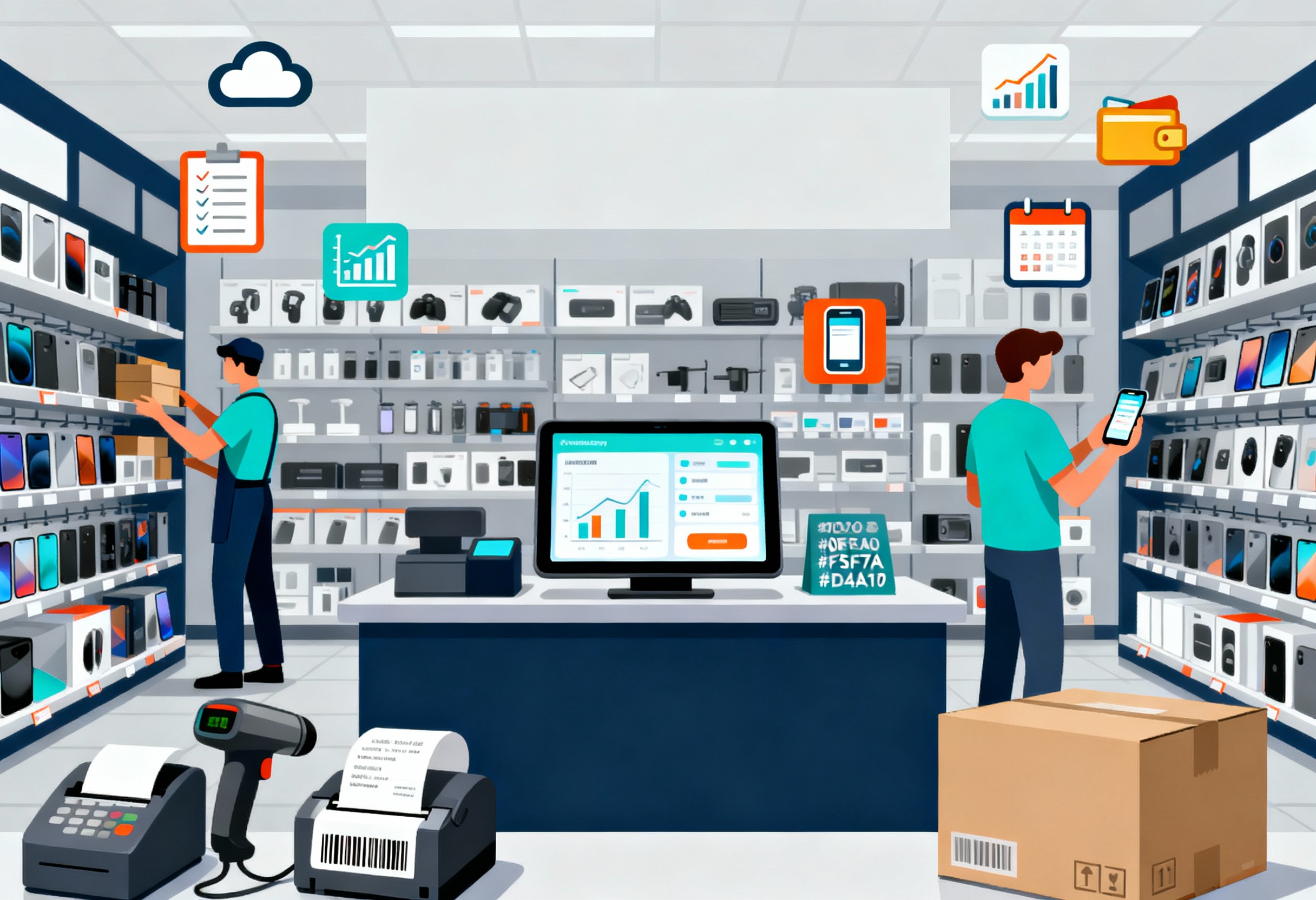Running an electronics store comes with many moving parts, from managing inventory to delivering smooth customer service. A reliable electronics store management software can simplify these tasks, but getting the most out of it requires a smart approach. By learning how to use the software effectively, you can improve efficiency, reduce errors, and create a better shopping experience for your customers.
This guide shares practical tips to help you make the software work for you, ensuring smoother operations and stronger results for your business. With the right strategies, your system becomes more than a tool – it becomes a growth partner.
Highlights
- Electronics stores deal with high-value items, serial tracking, fast product cycles, and multi-channel sales, all of which demand precise inventory control and flexible system support.
- Accurate inventory, solid reporting, system training, and smooth POS integration make it easier to get the most out of your electronics store software.
Unique Characteristics of Electronics Stores
Electronics stores operate differently from many other retail businesses because of the unique nature of their products and customer expectations. Below are several characteristics that make management more complex. These traits highlight the need for specialized tools to manage electronics retail effectively.
- High-value products: Electronics are expensive items, which makes accurate inventory control and strong theft prevention measures critical.
- Serial numbers and warranties: Each product usually comes with a unique serial number and warranty. Tracking these details is necessary to handle after-sales service, repairs, and customer claims.
- Rapid product turnover: Models change quickly as new technology is released. Stores must adapt inventory and sales strategies to keep up with frequent upgrades.
- Bundling and accessories: Many products are sold with add-ons, valued at US$47.3 billion in 2022. For example, a laptop may be paired with a case or software, and a phone with chargers or headphones.
- Multi-channel demand: Customers expect to browse and buy both online and in-store, requiring consistent management across sales channels.
- Complex return policies: Returns often involve exchanges, repairs, or warranty claims, which adds another layer of management.
Tips to Utilize Your Electronics Store Management Software with Ease
What do you need to do to take the most advantage of your electronic store management software?
Keep Your Inventory Accurate and Up-to-Date
Accurate inventory management is the backbone of a successful electronics store. Your management software can simplify this process when used effectively. To keep your stock precise and up-to-date, focus on these key practices:
- Use barcode or QR code scanning: This reduces manual errors and speeds up stock updates during sales, returns, or transfers.
- Automate low-stock alerts: Set reorder points in your system so you never run out of popular items. This ensures shelves stay filled with what customers need.
- Track serial numbers and warranty details: Proper tracking makes after-sales service smoother and protects against disputes.
- Monitor product variations: Electronics often come in multiple models or configurations. Recording each variation helps prevent mix-ups and supports better sales reporting.
Leverage Reporting & Analytics for Smarter Decisions
Reporting and analytics are powerful features in electronics store management software. They help you understand sales trends and guide smarter decisions. To make the most of these tools, focus on the following:
- Monitor top-selling products: Identify which items drive the most revenue. This allows you to prioritize stock and promotions for high-demand products.
- Track customer demand: Learn what your customers buy most often and adjust inventory or marketing strategies to match their preferences.
- Identify slow-moving items: Spot products that sit too long on shelves and apply targeted discounts to clear space for newer models.
- Forecast demand: Use historical data to predict demand for seasonal peaks or upcoming tech launches. This reduces the risk of stockouts or excess inventory.
Streamline Customer Experience with POS Integration
A smooth checkout and reliable after-sales service are essential in electronics retail. Integrating your POS with store management software creates a unified system that improves customer experience. Here’s how it helps:
- Fast and accurate checkout: Syncing POS with inventory ensures each transaction updates stock automatically, reducing errors and saving time at the counter.
- Flexible payment methods: Customers expect multiple options such as credit cards, e-wallets, or buy-now-pay-later (BNPL). Offering these choices makes purchases easier and more convenient.
- Stored purchase history: Keeping track of customer records simplifies warranty claims and after-sales support. Staff can quickly pull up past transactions, making service faster and more reliable.
Manage Multi-Channel Sales Seamlessly
Managing sales across multiple channels can be challenging without the right tools. Your electronics store management software can simplify this by keeping everything connected. Key practices include:
- Sync inventory across all channels: Ensure your physical store, eCommerce site, and online marketplaces share the same stock data. This prevents overselling and builds customer trust.
- Support BOPIS and delivery: Customers appreciate flexibility. Allow them to buy online and pick up in-store or choose delivery for added convenience.
- Maintain consistent pricing and promotions: Shoppers expect the same deals everywhere they interact with your brand. Unified pricing avoids confusion and improves brand reputation.
Train Your Staff to Use the System Efficiently
Your store management software is only as effective as the people using it. Training staff properly ensures smooth operations and fewer mistakes. Focus on these practices:
- Provide role-based permissions: Assign access based on responsibilities. This improves security and prevents employees from handling tasks outside their scope.
- Simplify workflows with dashboards: Create clear, tailored dashboards so staff see only the tools and data they need. This reduces confusion and speeds up daily tasks.
- Offer regular training sessions: Technology evolves, and new features may be added. Ongoing training keeps employees confident and capable of using the system effectively.
Use Integrations to Extend Software Capabilities
Integrations expand the power of your electronics store management software, making it more than just an inventory and sales tool. By connecting it with other systems, you create a unified workflow that saves time and improves accuracy. Key integrations include:
►►► Optimal solution set for businesses: Multi store POS, Next-gen POS, Inventory Management Software (MSI), Self Service, Automation, Backorders
- Accounting tools: Syncing with accounting software ensures financial data is always accurate. Sales, expenses, and tax details are updated automatically, reducing manual entry and errors.
- CRM POS systems: Integration with customer relationship management platforms helps track loyalty, personalize marketing campaigns, and strengthen long-term customer relationships.
- Shipping and supplier systems: Linking to fulfillment and supplier networks streamlines ordering, delivery tracking, and restocking, creating a smoother supply chain.
ConnectPOS – A Market-Recommended Electronics Store Management Software
ConnectPOS is designed to transform electronics retail operations by providing powerful tools that enhance both efficiency and customer experience. The system supports every stage of store management with practical, user-friendly features:
- Smart inventory management: ConnectPOS monitors stock levels in real time, tracks items with serial numbers, and conducts precise stock counts to ensure accuracy.
- Enhanced sales fulfillment: ConnectPOS streamlines order processing by supporting convenient options such as click-and-collect, which helps retailers deliver products to customers more efficiently.
- Flexible payment options: The system supports all major payment providers and allows stores to run promotions like layaway, buyback, or buy now, pay later.
- Multi-store management: The software unifies online and offline stores on one centralized platform and allows retailers to manage multiple outlets across different locations seamlessly.
- Efficient catalog management: Retailers can organize products by brand, color, size, or backend details such as IMEI, warranty numbers, and serials.
- In-depth product performance monitoring: ConnectPOS provides advanced analytics and reporting tools that help businesses track sales trends, measure performance, and identify top-performing items.
With these features, ConnectPOS enables electronics POS retailers to simplify daily operations, improve accuracy, and drive sustainable growth.
In Conclusion
Managing an electronics store involves unique challenges, from handling high-value inventory to supporting complex after-sales services. With the right electronics store management software, you can simplify operations, improve accuracy, and deliver a seamless customer experience across every channel. By applying best practices such as accurate inventory tracking, leveraging analytics, integrating POS, and training your staff, your business can operate more efficiently and stay competitive in a fast-changing market.
ConnectPOS offers all the essential tools to help electronics retailers grow with confidence. If you’re ready to streamline your operations and unlock new opportunities, contact us today to power your electronics store’s success.
FAQs: Electronics Store Management Software
Can store management software handle warranty and serial number tracking?
Yes. Modern electronics store management software is designed to record serial numbers and warranty details for each product. This makes it easier to process returns, handle repairs, and provide reliable after-sales support. It also reduces the risk of errors or disputes with customers.
How does software help manage multi-location electronics stores?
The software unifies all sales channels and store locations on one centralized platform. Retailers can monitor inventory levels, track performance, and update pricing across multiple outlets in real time. This ensures consistency and simplifies managing several stores at once.
What’s the best way to train staff to use the system effectively?
The best approach is to provide role-based access, simplify dashboards for everyday tasks, and offer regular training sessions. Clear workflows and ongoing practice build staff confidence and reduce mistakes when using the system.
How can I prevent overstocking or understocking popular electronics items?
You can prevent stock issues by setting automated low-stock alerts, tracking sales patterns with analytics, and forecasting demand based on trends or upcoming product launches. This ensures you reorder at the right time and keep shelves stocked with in-demand items.
►►► Optimal solution set for businesses: Shopify POS, Magento POS, BigCommerce POS, WooCommerce POS, NetSuite POS, E-Commerce POS



